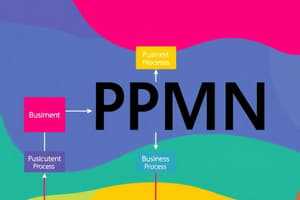Podcast
Questions and Answers
What is the primary purpose of BPMN (Business Process Modeling Notation)?
What is the primary purpose of BPMN (Business Process Modeling Notation)?
- To provide a database management system for business processes
- To create complex code for business applications
- To support business process modeling with standardized notation (correct)
- To replace traditional flowchart techniques completely
Which of the following correctly describes a gateway in BPMN?
Which of the following correctly describes a gateway in BPMN?
- A decision point that can adjust the path based on conditions or events (correct)
- A representation of the end of a business process
- A tool for managing data storage across different departments
- An element that is only used for exclusive pathways
What does the sequence flow illustrate in a BPMN diagram?
What does the sequence flow illustrate in a BPMN diagram?
- The interaction between different organizational units
- The potential issues that can arise during a process
- The structural relationship between different processes
- The order in which activities are to be performed (correct)
What is a pool in BPMN terminology?
What is a pool in BPMN terminology?
Which of the following best describes an event in BPMN?
Which of the following best describes an event in BPMN?
What are the two classifications of events in BPMN?
What are the two classifications of events in BPMN?
What is the purpose of a data object in a BPMN diagram?
What is the purpose of a data object in a BPMN diagram?
Which of the following describes an annotation in BPMN?
Which of the following describes an annotation in BPMN?
In BPMN, what does a group signify?
In BPMN, what does a group signify?
What is the role of an activity in BPMN?
What is the role of an activity in BPMN?
Study Notes
Business Process Modeling Notation (BPMN)
- Developed by the Business Process Management Initiative (BPMI) and adopted by the Object Management Group (2005).
- A standard notation aimed at bridging business process design and implementation.
- Facilitates communication among stakeholders in business process management.
- Utilizes a flowchart-like notation that is easy to understand for business users but detailed enough for technical users.
Key Components of BPMN
- Gateway: A decision point that directs the flow based on conditions. Types include exclusive, inclusive, parallel, and event-based.
- Flow Objects: Includes events (triggers for processes), activities (tasks), and gateways (decision points).
- Connecting Objects:
- Sequence Flow: Indicates the order of activities.
- Message Flow: Represents messages exchanged between organizational units.
- Association: Connects artifacts to elements like events or activities.
Swimlanes in BPMN
- Pool: Represents major participants in a process, potentially from different organizations.
- Lane: A subdivision within a pool, reflecting the responsibilities of particular roles within the process.
Artifacts in BPMN
- Data Object: Shows data necessary for an activity.
- Group: Represents logical grouping without affecting flow.
- Annotation: Provides additional context or explanations.
Unified Modeling Language (UML)
- A standardized modeling language for software architecture and design.
- Evolved from methodologies like the Booch Method, Object Modeling Technique (OMT), and Objectory.
- Employed primarily by programmers and offers various diagram types for different system aspects.
Types of UML Diagrams
-
Structural Diagrams:
- Class Diagram: Describes static structure.
- Package Diagram: Organizes system elements into groups.
- Object Diagram: Displays system structure at a specific time.
- Component Diagram: Shows organization of software components.
- Deployment Diagram: Illustrates physical resources and connections.
-
Behavioral Diagrams:
- Activity Diagram: Represents dynamic flow of control.
- Use Case Diagram: Models system functionalities from a user perspective.
- State Machine Diagram: Describes behavior in response to events.
- Sequence Diagram: Models object interactions in order.
- Communication Diagram: Illustrates message exchanges over time.
Architecture Description Language (ADL)
- A general term for formal languages that help in defining and modeling software architectures.
- Essential properties include representing components, connectors, and dynamic architectures.
- Examples of ADLs: UniCon, Wright, Acme.
- A good ADL supports modeling complexities and analysis tools while ensuring architectural integrity.
Studying That Suits You
Use AI to generate personalized quizzes and flashcards to suit your learning preferences.
Related Documents
Description
Test your knowledge of Business Process Modeling Notation (BPMN), a standardized method for illustrating business processes. This quiz covers key components, such as gateways, flow objects, and connecting objects, facilitating effective communication among stakeholders. Learn how BPMN aids in bridging the gap between business process design and implementation.




